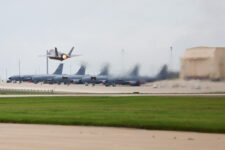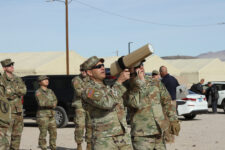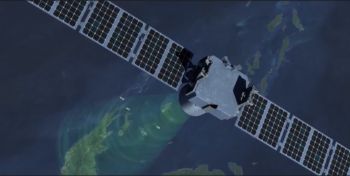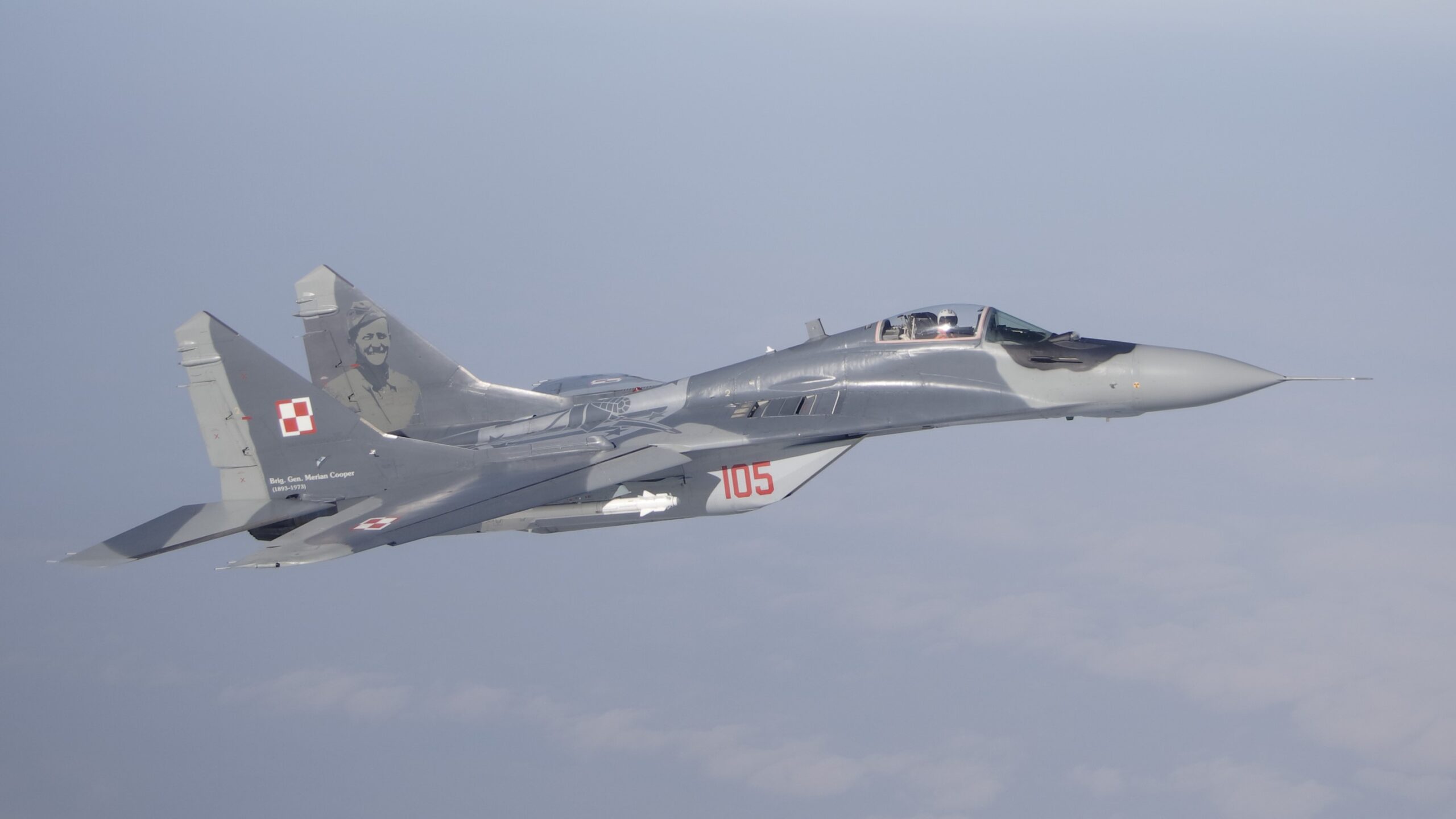
A Polish MiG-29 flies over Lithuania during a NATO mission in 2015. (Bartosz Glowacki/staff)
WARSAW: When the saga of Ukraine and the MiG-29 played out last month, the plan seemed fairly simple: Poland would ship its Russian made jets to Ukraine and the US would provide older-configuration Lockheed Martin F-16 fighters to Poland as a replacement.
But while politics and loose lips appear to have sunk that deal, Poland has not given up on finding backfill options if it decides to transfer its MiGs in the future — and neither have defense aviation firms from around the world, who smell an opportunity to break into the Polish market.
Ukraine, meanwhile, continues to sound the alarm that new planes are needed not just to continue the air defense against Russia, but because its own fleet of MiG-29s will soon need parts and ammunition following the loss of domestic manufacturing capability. Wear and tear on the MiG-29s caused by a grueling op-tempo of daily sorties by the Ukrainian Air Force (PSU) cannot be addressed, as the repair and maintenance facilities in Ukraine that normally support the continued operation of the MiGs have been destroyed by Russian cruise missile strikes.
Polish officials have been clear that they will not be giving away the MiGs without backfill from somewhere. While the F-16 was the primary option being sought, Poland is now considering a trio of other options in case it wants to move forward with shipping the MiGs across the border. The immediate aftereffect has been the Polish Ministry of National Defence quietly entertaining presentations by different combat aircraft suppliers — but without any official announcement or issuance of a real Request for Information.
The first option is an Italian offering of an armed, combat-capable version of the Leonardo/Alenia Aermacchi M-346 Master. The Italians have been attempting to sell a combat-capable version of this trainer into an attack platform for some time. In Poland, the M-346FA, as it is designated in this configuration, would be proposed not only as a MiG-29 replacement but also a substitute for the Sukhoi Su-22s in Polish service.
Leonardo’s proposal is that the aircraft is a lower cost, dual-role platform that could supplement the initial trainer versions already operated by the Poles. The company’s pitch to Warsaw, according to a formal presentation viewed by Breaking Defense, is that “the use of an extended, combat version of this proven aircraft, the M-346FA, can also be beneficial. It is a lightweight multi-role aircraft equipped with a radar, which is a very profitable, tactical solution for the modern battlefield.
“The machine is equally well suited for air-to-surface tasks, air-to-air missions and tactical reconnaissance missions,” the pitch continues. “It can perfectly replace the 20-30 tonne fighter-bomber aeroplanes that are expensive to purchase and operate in less demanding direct air support tasks or anti-insurgency operations.”
Meanwhile, a senior delegation from the Republic of South Korea (ROK) is travelling to Poland to propose the Korean Aerospace Industries (KAI) FA-50 light attack aircraft. As an indicator of how badly KAI would like to seal the deal, included in the delegation, expected this week, is the South Korean Deputy Defense Minister.
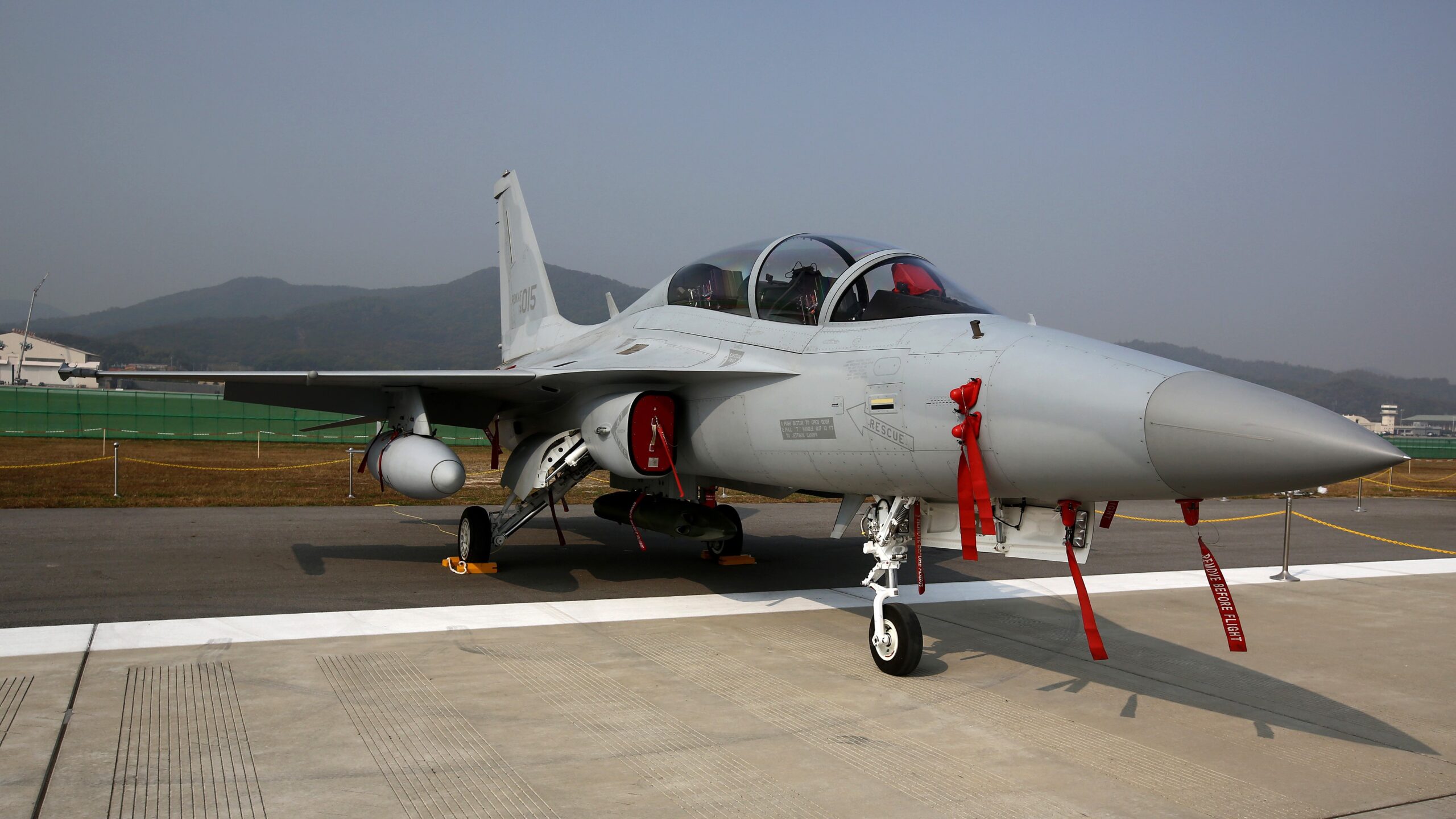
An FA-50 Golden Eagle jet, manufactured by Korea Aerospace Industries Ltd., stands on display at the Seoul International Aerospace & Defense Exhibition (ADEX) in 2015. (SeongJoon Cho/Bloomberg via Getty Images)
Like the armed M-346 option, the FA-50 is an adaptation of a training aircraft into a combat platform. The advantages here are the supersonic performance of the FA-50 and its compatibility with the F-16 models already in Polish service.
The FA-50 can also be fitted with an active electronically-scanning array (AESA) radar set. One of the options discussed is a derivative of the Northrop Grumman (NG) AN/APG-83 designed for the F-16V program. This would be a version of the same Korean-built AESA developed for the ROK’s own KF-X indigenous fighter project.
The Korean radar is a step up in technology from the NG design as it would be built with gallium nitride (GaN) technology instead of the previous-generation gallium arsenide (GaAs). The KF-X AESA is designed to have more than 1,000 transmit-receive modules (TRM) with a beam-steering angle would be up to 60 to 70 degrees. If the Poles were to procure this option, it would provide some synergy and datalink compatibility in operation with their existing F-16C/D Block 52+ models.
Union workers strike at Pratt & Whitney plant where F-35 engine is made
Pratt & Whitney said in a statement that it has “contingency plans in place to maintain operations and meet our customer commitments” and has no “immediate” plans to resume negotiations with the union.
The other advantage for the FA-50 is that KAI have completed integration of the LM Sniper targeting pod that is utilized by 27 different air forces around the world — including Poland, which has the Sniper in inventory for its current F-16 fleet.
Current planning in Warsaw would call for 32 of either the M-346FA or FA-50 to be procured, but there is also a third proposal for Poland to receive 12-16 of the older, used Tranche 1 Eurofighters from Italy. (Ideally, these would later be supplemented by the latest Tranche 4 models at some point in the future.) The advantage of the cast-off Eurofighters is that they would be available straightaway and could be delivered sooner than any of the other proposed solutions.
Another possibility being discussed internally in Poland is a lease for 32 Saab JAS-39C/D Gripen models. The Gripen-E is a more advanced variant and could be delivered later when the lease would be up, but initially the C/D models would be available in the shortest time frame.
The attractiveness of the Gripen from an operational standpoint is that they are the only western design that is capable of being operated from dispersed basing in the same manner is the MiG-29s that they would be replacing. Polish sources state that their air force is interested in retaining a dispersed basing capacity and how it enhances survivability after having seen the performance of the PSU against Russian air power when employing this operational concept.
Gripen’s other advantages, as Saab officials have pointed out to Breaking Defense, is that the aircraft is available with any weaponry that the customer would choose — US, European, Israeli, Brazilian or South African. More importantly from the standpoint of being able to intercept Russian aircraft at long ranges is that the Gripen is the only aircraft being considered by Poland that carries the MBDA Meteor BVR ramjet-powered air-to-air missile.
However, selecting Gripen would mean introducing a plane into NATO efforts at a time when other alliance members are focusing heavily on interoperability.
Will Poland Spend?
There are still two overriding issues for Poland in any attempt to upgrade its fleets as part of a MiG-29 trade. First, acquisition of any of these models would mean that once the Lockheed Martin F-35s are delivered in the 2026 time frame, the Polish Air Force would be operating and supporting three disparate models of aircraft — creating a complicated logistical system.
Second, there is the larger hurdle that Poland wants to receive either free, used aircraft or some other cheap option in return for handing the MiG-29s over to Ukraine. This makes the other European possibilities less attractive for the simple fact that the Poles would have to pay for these aircraft, unless the EU would agree to fund the acquisition in return for the MiG-29s being transferred to Kyiv.

An M346 aircraft take flight during the 2014 Farnborough Air Show. (Dan Kitwood/Getty Images)
And behind closed doors in Warsaw there is also apprehension about the potential implications of the transfer of a major platform like the MiG to Ukraine – hence the very low-key process of receiving proposals from OEMs for the Russian-design aircraft’s replacement.
“Poles have been supplying this country [Ukraine] with weapons for a long time,” one diplomatic source in Warsaw said, echoing comments others in the city have made. “But it cannot be ruled out that too vigorous support for Ukraine may lead to retaliatory blows from Moscow on Polish territory.”
For this and other reasons the Polish PM, Mateusz Morawiecki, has stated that providing the MiGs to Ukraine would have to be taken by NATO as a decision by NATO collectively and not Poland on its own.
But both opposition leaders and defense analysts in Warsaw decry Poland’s ineffective procurement system and voice their skepticism about the process being carried out. The mechanisms that exist are “well versed in going through the procedures of processing major weapon systems for years on end,” said a major defense industry lobbyist in Warsaw, “but they have produced no major acquisitions other than the decision to purchase the F-35.”
Still languishing after years of deliberation are a decision to acquire an attack helicopter – the most likely choice being between the Boeing AH-64E Apache and the Bell AH-1Z – as well as a program to procure an effective ATACMS capacity like the LM MGM-140.
The Situation Above Ukraine
As the decision on the transfer of the MiG-29s to Ukraine remains in limbo, the PSU continues to surprise western defense experts and officials with its relative success against Russia.
According to a recent detailed report on the operational success of the PSU, Russia has only established air superiority over some small sections of airspace in the southern and eastern regions of Ukraine. Over most of the country, airspace remains contested, with the PSU continuing to sortie for combat missions daily.
PSU pilots and other military officials have stated they need the Polish MiG-29s and other Soviet-era aircraft to maintain their op-tempo against the Russian forces. Adding the Polish MiG-29s to Ukraine’s inventory would increase the size of Kyiv’s fleet by 50 percent. The attrition rate within the PSU — due to maintenance problems as well we combat losses — is such that these added aircraft may be the only means by which the PSU can continue to perform their mission.

Ukrainian Air force MIG 29 fighter planes take part in practical flights during an exercise at the Air Force military base in Vasylkiv, some 40km from Kiev on August 3, 2016. (SERGEI SUPINSKY/AFP via Getty Images)
Europe could, on paper, add some 70 of the Soviet-era fighter jets to the beleaguered PSU, but only If Bulgaria and Slovakia agreed to send their fleets of MiG-29s along with Poland.. However, both of these nations have declined to do so, on the grounds that this would mean leaving their air forces without any fighter platforms until years from now when they will receive the US-made F-16V Block 70/72 models they have on order.
Bulgarian Prime Minister Kiril Petkov stated that his air force did not have enough serviceable aircraft or parts, and its MiG-29 force is not adequate to secure its own airspace. “We currently have few flying planes and they cannot be delivered to another country,” Petrov was quoted in the European Euractiv news service.
And as rugged and as dependable an aircraft as the MiG is known for being, it is still susceptible to the normal wear-and-tear and down times associated with any combat aircraft. Additional MiG-29s are needed not only to replace the Ukrainian aircraft that are experiencing availability problems after flying so many sorties, but because of supply chain issues.
The chief repair and support depot for the MiG-29s in all of Ukraine, the L’viv State Aircraft Repair plant, was destroyed in a recent Russian missile attack. Therefore, the PSU require not only the Polish MiG-29s, but also the supplies of Polish spare parts, and a plus-up in the number of air-to-air missiles (AAM), most of which are manufactured by the Artem plant in Kyiv.
Eventually Ukraine would be looking for more advanced western aircraft, but the training and maintenance required to operate a new fleet of jets makes any addition impossible during the ongoing war. Still, it is worth considering what options may be on the table for Ukraine in the future.
Some version of the F-16 has been mentioned as the most likely candidate as the next step for Ukraine. One of the more plausible scenarios would be for the Ukrainians to operate an aircraft similar to what Poland’s armed forces are equipped with, so that the two countries could share and collaborate on the process of supporting them.
This would follow the model of cooperation that has existed for many years between the Poles and the Ukrainians on operating their MiG-29s independent of the Russians, but there are additional sticking points that would have to be resolved as well.
There are “numerous export-control issues that would be associated with transferring US-made aircraft and the sensitivity of the avionics and other on-board systems,” said a Warsaw-based defense industry lobbyist. “These are all solvable problems, but there needs to be the political will to make it happen.”
